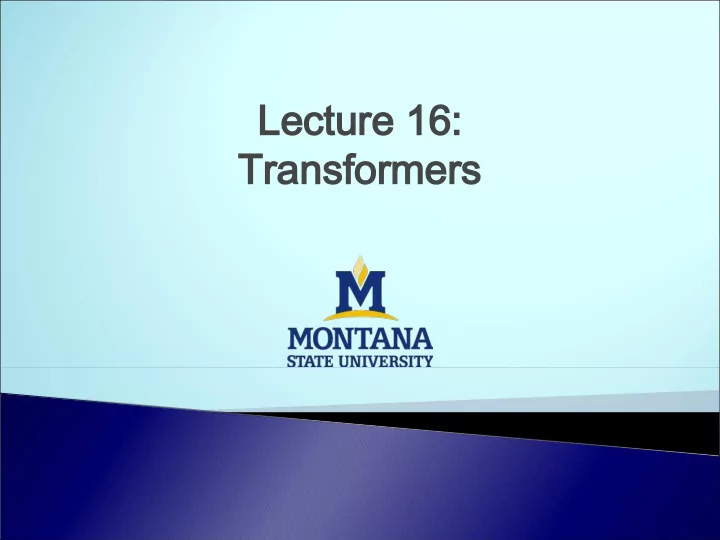

Lectur Lecture 16: e 16: Tr Transfor ansformer ers
Electr Electrical Tr ical Transm ansmission ission • Electrical equipment use low voltage – 120 V, 240 V, 277 V, 480 V • Electricity generated at medium voltages – Generally between 13 kV to 100 kV • Electrical transmission at high voltages – 100 kV to 765 kV • Long distance transmission (rural areas) – Greater than 765 kV
Electr Electrical Tr ical Transm ansmission cont. ission cont. • Electrical equipment use low voltage – Primarily for safety • Electrical transmission at high voltages – Efficient – Cost effective • Transmission Losses – Some resistance in cables 2 R P = I Reduce current = less loss
Tr Transfor ansformer ers • Used to change the voltage level – Step-up transformers increase voltage – Step-down transformers decrease voltage • Power system applications – Step-up for transmission – Step-down for distribution – Maintain voltage levels of distribution • Other applications – Electrical isolation – Impedance matching (e.g. audio systems)
Transfor Transformers in t ers in the E he Elect lectrical rical Power Power System System Step-up transformer Step-down transformer Step-down transformer
Tr Transfor ansformer er Oper Operation ation Applied AC current induces magnetic flux AC magnetic flux induces voltage on output
Tr Transfor ansformer er Oper Operation ation d d Relationship: E p = N p E s = N s Relationship: dt dt Combined: E p = N p E s N s
Tr Transfor ansformer er Oper Operation ation Load draws current For ideal transformer and thus, power (100% efficient), power in equals power out Current draw at output Causes current draw at input
Tr Transfor ansformer er Oper Operation ation Power in: P p = I p E p Power out: P s = I s E s E p = N p From before: and P p = P s (if 100% efficient) E s N s I s = N p So combined I p N s
Exam Example ple A transformer for a house is designed to decrease the line distribution voltage from 7800 V to 120 V. Assuming an ideal transformer, what should the turns ratio be? Turns ratio: N p N s
Exam Example ple A transformer for a house is designed to decrease the line distribution voltage from 1200 V to 120 V. Assuming an ideal transformer, what should the turns ratio be? Turns ratio: N p N s N p = E p = 1200 120 = 10 N s E s Thus, there should be 10 turns on the secondary for every single turn on the primary.
Another Another Exam Example ple If the transformer is connected to a load drawing 50 A of current, how much current is being drawn on the primary? Assume an ideal transformer.
Another Exam Another Example ple If the transformer is connected to a load drawing 50 A of current, how much current is being drawn on the primary? Assume an ideal transformer. I s = N p I p = N s → I s I p N s N p N p = 10 N s I s = 50 A I p = N s I s = 1 10 50 = 5 A N p
Non- Non-idealities idealities • Of course, no transformer is ideal – Power transformers generally 85% to 99% efficient – Small transformers less so – Efficiency depends on materials, construction, and load • Power Losses – Copper losses 2 R • Resistance in windings ( ) I – Magnetic losses • Primary current required for magnetic flux excitation • Magnetic flux leakage • Magnetic hysteresis • Eddy current losses
Tr Transfor ansformer er M Model odel Symbol in a circuit diagram: When considering losses and reactance:
Tr Transfor ansformer er M Model odel Symbol in a circuit diagram: Polarity in Diagram: Two general methods to indicate same relative polarity: - Dots - Letter markings (usually H for primary, X for secondary)
Tr Transfor ansformer er Losses M Losses Modeled odeled Resistances used to model various losses Inductors used to model self-inductance
Tr Transfor ansformer er Constr Construction uction Primary and secondary windings usually wound together - minimize leakage Transformer core - Typically iron or steel - Laminated sheets to minimize eddy current losses
Methods for ethods for Cooling Cooling Tr Transfor ansformer ers • Losses result in heat • • Small transformers generally air cooled (5 kVA or less) • Small to medium distribution transformers cooled by oil • Large transformers – require external radiators
Special Tr Special Transfor ansformer ers Tapped Transformers • Multiple connection points on one side of transformer – Mechanically removes turns from transformer – Used to regulate voltages in power system
Autotr Autotransfor ansformer ers Autotransformers • Only has one winding – One portion of winding for both primary and secondary • Standard equations still apply • Require less copper – Cheaper – Smaller • Disadvantage is more hazardous
Upcom Upcoming in class ing in class 3-phase systems • Circuits – Delta and Wye connections • Transformers • New homework on D2L – Due Wednesday 11/06 • CHANGE TO SYLLABUS – There IS lab next week – We will do project later (probably week before Thanksgiving)
Recommend
More recommend